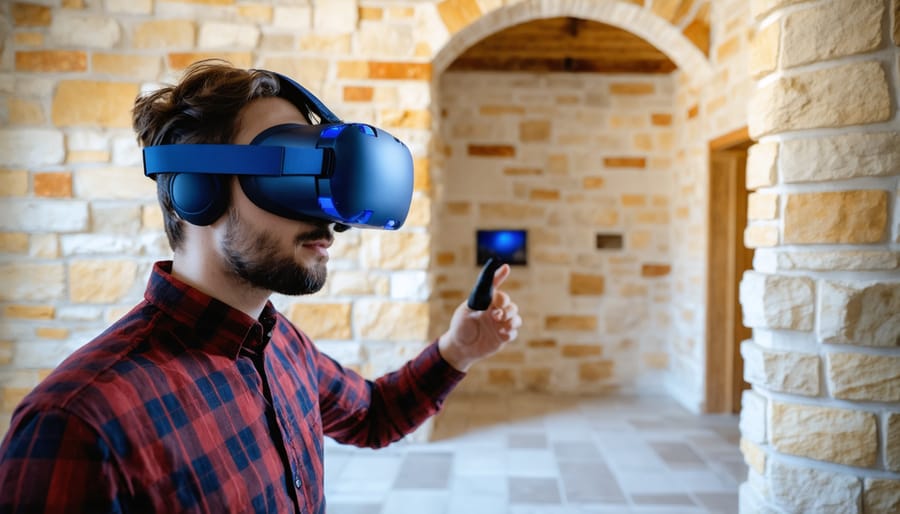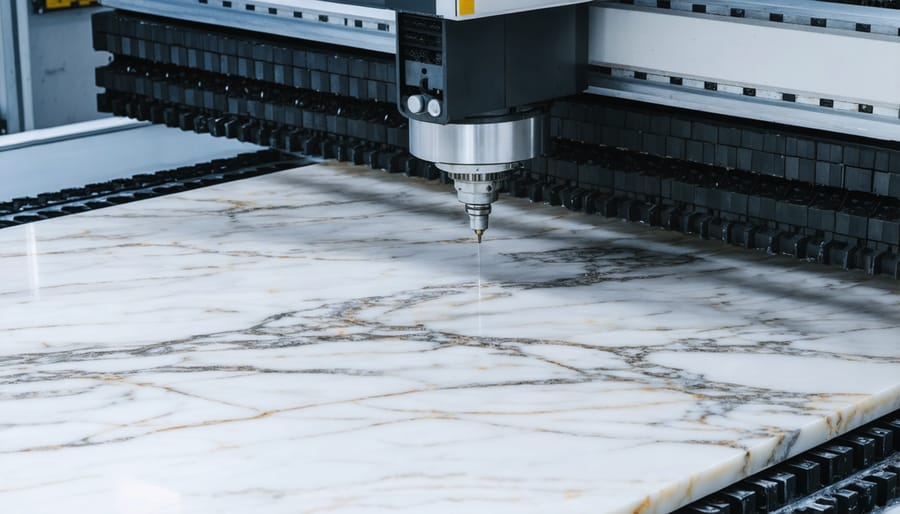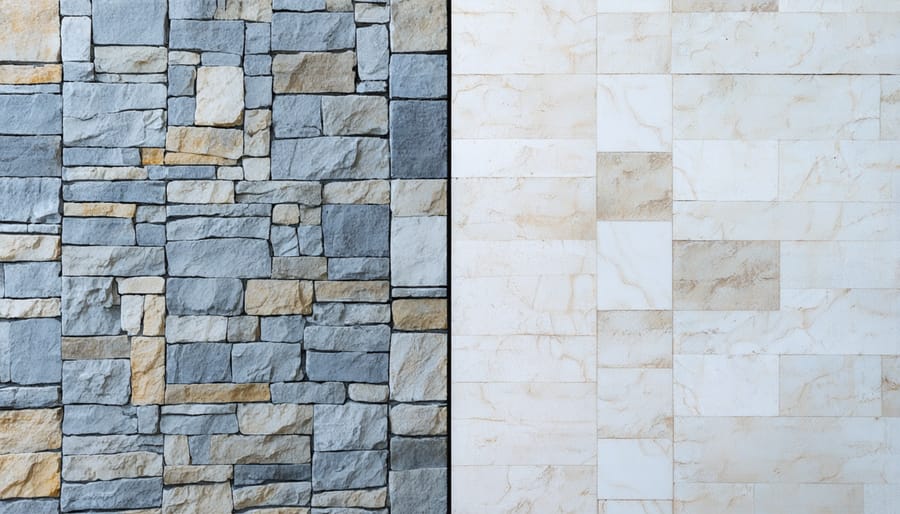Natural stone transforms ordinary spaces into timeless masterpieces, blending raw geological beauty with sophisticated interior design. From the veined elegance of marble to the rugged character of slate, these ancient materials are experiencing a revolutionary renaissance through modern technology and installation techniques.
Today’s natural stone applications extend far beyond traditional flooring and countertops. Advanced fabrication methods now allow for impossibly thin stone veneers, seamless book-matching, and intricate three-dimensional wall treatments that were unimaginable a decade ago. Innovative sealants and maintenance solutions have also eliminated many of the practical concerns that once limited stone’s use in high-traffic areas.
Leading architects and designers are increasingly turning to natural stone for its unmatched sustainability credentials and ability to create biophilic connections in contemporary spaces. Each slab tells a unique story formed over millions of years, offering patterns and colorways that synthetic materials simply cannot replicate. As technology continues to evolve, natural stone remains firmly anchored at the intersection of timeless luxury and modern innovation, providing endless possibilities for creating extraordinary interior environments.
Smart Stone Selection Technologies
3D Visualization Tools
Modern 3D visualization tools have revolutionized how we plan and implement natural stone installations in interior spaces. Virtual Reality (VR) and Augmented Reality (AR) technologies now allow homeowners, designers, and architects to preview stone selections and layouts before making final decisions or beginning installation work.
Using specialized software, clients can virtually walk through their spaces and see exactly how different stone varieties will look in their intended locations. This technology accounts for lighting conditions, surrounding materials, and even the subtle variations in stone patterns, providing an incredibly realistic preview of the final result.
AR applications on smartphones and tablets enable users to point their devices at a space and instantly visualize how various stone options would appear in real-time. This helps in making crucial decisions about stone types, patterns, and layouts while eliminating much of the guesswork traditionally involved in material selection.
These visualization tools also assist in technical planning, allowing contractors to identify potential installation challenges and develop solutions before work begins. They can calculate precise material quantities, plan cutting patterns to minimize waste, and ensure optimal pattern alignment for aesthetic appeal.
For complex projects, these tools prove invaluable in communicating design intent between clients, designers, and installers, reducing the likelihood of costly mistakes or misunderstandings during the installation process.

Digital Stone Matching
Modern technology has revolutionized the way natural stone is matched and installed through sophisticated digital pattern matching software. These advanced tools allow designers and installers to create seamless stone layouts by precisely aligning veins, patterns, and colors across multiple slabs.
The process begins with high-resolution scanning of stone slabs, capturing every detail of the material’s unique characteristics. These digital images are then processed through specialized software that analyzes the stone’s patterns, creating detailed maps of veining and color variations. Installers can virtually arrange slabs before cutting, ensuring optimal pattern continuity and minimal waste.
This technology is particularly valuable for book-matching applications, where stone slabs are mirrored to create dramatic symmetrical patterns. The software can simulate different arrangements, allowing clients to visualize the final result before any cutting begins. It also helps in complex projects where multiple slabs need to be matched across large surfaces, such as feature walls or continuous floor patterns.
Digital stone matching has significantly reduced installation errors and material waste, while enabling more ambitious design possibilities. The technology can even account for the stone’s thickness and finish, ensuring that pattern alignment remains precise regardless of how the material is processed or installed. This innovation has become an indispensable tool for achieving the highest level of precision and aesthetics in natural stone installations.
Innovative Installation Methods
Precision Cutting Systems
Modern precision cutting technologies have revolutionized how natural stone is shaped and customized for interior applications. Computer Numerical Control (CNC) machines now enable craftsmen to achieve unprecedented levels of accuracy and intricacy in stone cutting, with tolerances as fine as 0.1 millimeters.
Water jet cutting systems, which use high-pressure water mixed with abrasive particles, can slice through even the hardest stone materials while maintaining their structural integrity. This technology allows for intricate inlay work, complex geometric patterns, and seamless joins that were previously impossible or extremely time-consuming to achieve by hand.
Laser-guided bridge saws represent another significant advancement, offering automated cutting processes that ensure perfect straight lines and precise angles. These machines can handle large stone slabs efficiently, reducing waste and maximizing material usage. The integration of digital templating systems allows designers to create virtual mock-ups of their designs before any cutting begins, ensuring perfect fits and reducing costly errors.
Multi-axis robotic arms equipped with diamond-tipped tools can now perform complex three-dimensional carving operations, creating everything from detailed architectural elements to custom sculptural pieces. These systems can work continuously, maintaining consistent quality while significantly reducing production time.
The latest software developments in stone cutting technology also enable sophisticated nesting algorithms, which optimize how patterns and pieces are arranged on stone slabs to minimize waste. This not only reduces material costs but also promotes sustainable practices in stone fabrication, making natural stone an increasingly eco-friendly choice for interior applications.

Advanced Mounting Solutions
Modern mounting solutions have revolutionized the way natural stone is installed in interior spaces, offering enhanced stability, easier installation, and better long-term performance. mechanical anchoring systems now utilize advanced stainless steel brackets and clips that allow for precise adjustments during installation, ensuring perfect alignment and secure attachment to various substrate materials.
One notable innovation is the development of integrated ventilation systems within mounting frameworks. These systems create a small air cavity between the stone and wall surface, preventing moisture buildup and extending the life of both the stone and supporting structure. This approach has proven particularly effective in bathroom and kitchen installations where moisture management is crucial.
Mechanical kerf anchoring has evolved to include adjustable brackets that accommodate stones of varying thicknesses while providing superior load distribution. These systems also allow for easier maintenance access and stone replacement if needed, without disturbing adjacent panels.
Advanced adhesive technologies now combine with mechanical supports to create hybrid mounting solutions. These systems use specially formulated structural adhesives that maintain flexibility while providing exceptional bonding strength. They accommodate natural thermal movement of stone while ensuring secure attachment, particularly important for large-format panels and ceiling applications.
For curved surfaces and complex geometries, newly developed flexible mounting systems employ articulating brackets and customizable support frames. These solutions allow designers to realize ambitious architectural features while maintaining structural integrity and safety standards.
Digital templating and precise CNC fabrication have also improved mounting accuracy, enabling pre-drilled anchor points and perfect fit installations. This technology reduces on-site modifications and installation time while ensuring optimal support distribution across stone surfaces.
Stone Protection Technologies
Nano-Sealing Solutions
Nano-sealing technology represents a revolutionary advancement in natural stone protection, offering molecular-level defense against stains, moisture, and environmental damage. These cutting-edge sealants create an invisible, breathable barrier that penetrates deep into the stone’s surface while maintaining its natural appearance and texture.
Unlike traditional sealers, nano-sealants utilize particles so small they can fill microscopic pores in the stone, creating a more comprehensive and longer-lasting protection. This advanced technology forms chemical bonds with the stone’s surface, resulting in protection that can last up to 15 years with proper maintenance.
The benefits of nano-sealing extend beyond basic protection. These solutions enhance the stone’s resistance to UV radiation, prevent the growth of bacteria and mold, and make routine cleaning significantly easier. Many nano-sealants also offer oil and water repellency, making them ideal for kitchen countertops and bathroom surfaces where exposure to various substances is common.
Application of nano-sealants is typically straightforward, requiring minimal preparation and offering quick curing times. Most products can be applied using a spray or roller, and many achieve full effectiveness within 24-48 hours. However, professional application is recommended for optimal results, especially in large-scale projects or high-traffic areas.
While the initial cost of nano-sealants may be higher than conventional options, their extended durability and superior protection make them a cost-effective long-term investment for natural stone preservation.

Smart Maintenance Systems
Modern technology has revolutionized how we maintain natural stone surfaces, with smart maintenance systems leading the way in preserving stone’s beauty and longevity. These innovative solutions combine sensors, automated cleaning mechanisms, and intelligent monitoring to ensure optimal care for stone surfaces.
Advanced moisture detection systems can now alert homeowners to potential water damage before it becomes visible, while automated pH monitors help maintain the correct chemical balance for cleaning solutions. Smart scheduling apps remind users when specific maintenance tasks are due, taking the guesswork out of stone care routines.
IoT-enabled devices can track surface wear patterns and recommend preventive treatments based on actual usage data. Some systems even integrate with home automation platforms, automatically adjusting indoor humidity levels to protect sensitive stone surfaces.
Remote monitoring capabilities allow property managers and maintenance professionals to oversee multiple stone installations simultaneously, ensuring timely interventions when needed. These systems can detect early signs of deterioration through sophisticated imaging technology and provide detailed maintenance histories for better long-term care planning.
The latest maintenance technologies also include self-cleaning coatings that respond to environmental conditions and specialized UV protection systems that prevent fading in sun-exposed areas. These innovations not only simplify stone care but also contribute to extending the life of natural stone installations while reducing maintenance costs.
Sustainable Stone Innovation
In recent years, sustainable stone innovations have revolutionized how we approach natural stone in interior design. The industry has made remarkable strides in developing eco-friendly extraction methods, processing techniques, and installation practices that significantly reduce environmental impact while maintaining the material’s inherent beauty and durability.
Water recycling systems in quarries now recover up to 98% of water used in stone cutting and processing, dramatically reducing consumption of this precious resource. Advanced cutting technologies minimize waste by optimizing stone block utilization, ensuring that nearly every piece of extracted material serves a purpose. These remnants are often repurposed into smaller decorative elements or crushed for use in terrazzo and other composite materials.
Modern sealants and treatments have evolved to become more environmentally conscious while offering superior protection. Water-based, low-VOC sealers now provide excellent stone protection without harmful emissions, making them safer for both installers and occupants. These innovative products extend the life of stone surfaces while maintaining their natural appearance and reducing the need for frequent replacements.
The industry has also embraced closed-loop manufacturing processes, where stone waste is recycled into new products. Crushed stone remnants are increasingly used in sustainable building materials, from concrete alternatives to landscaping applications. Some manufacturers have developed techniques to transform stone processing byproducts into eco-friendly fillers and aggregates.
Transportation efficiency has improved through better packaging and logistics solutions, reducing the carbon footprint of stone delivery. Local sourcing initiatives have gained momentum, with designers and architects prioritizing regional stone varieties to minimize transportation distances and support local economies.
Smart quarrying techniques now incorporate advanced imaging technology to identify the highest quality stone deposits, reducing unnecessary excavation and preserving natural landscapes. These methods, combined with strict land reclamation practices, ensure that quarry sites can be effectively restored after use.
The integration of technology in natural stone interiors has revolutionized how we select, install, and maintain these timeless materials. Digital visualization tools have transformed the design process, allowing clients to preview stone patterns and layouts before making final decisions. Advanced fabrication technologies, including CNC machines and water jet cutting, have made previously impossible designs achievable while reducing waste and improving precision.
Maintenance and preservation of natural stone have also benefited significantly from technological advances. Smart sealants and nano-protective treatments now offer superior protection against stains and wear, while automated cleaning systems help maintain stone surfaces with minimal effort. These innovations have made natural stone more practical and accessible for both residential and commercial applications.
The marriage of traditional stone with modern technology has created new possibilities for sustainable design. Digital inventory management systems help quarries operate more efficiently, while 3D printing technologies are beginning to incorporate stone materials in revolutionary ways. As we look to the future, emerging technologies like augmented reality for stone selection and artificial intelligence for pattern matching will continue to enhance the natural stone industry.
This technological evolution hasn’t diminished the authentic beauty of natural stone; rather, it has made it more adaptable, sustainable, and practical for modern living while preserving its timeless appeal. The future of natural stone interiors lies in this perfect balance between ancient material and cutting-edge innovation.










